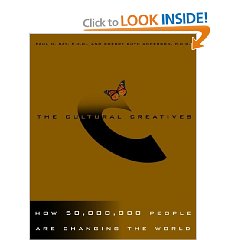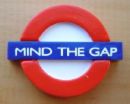This book should be read together with Imagine: What America Could be in the 21st century, edited by Marianne Williamson. Taken together, the two books are inspirational while still being practical.
Cultural Creatives as a book, and some of the other reviews, tend to over-sell the success of the emergence of an alternative lifestyle to Traditionalists (stereotyped as somewhat red neckish and religious rightists) and Moderns (stereotyped as ravish the earth anything-goes corporate carpetbaggers). The reality is that there are as many “cultural creatives” as there are people with disabilities in the United States–50 million. Not one quarter of the population, as one reviewer claims.
Having said that, by way of somber stage-setting, I cannot say enough good things about this book. It should be required reading for every citizen, every student, and every public official. In a very real sense, this book strikes me as a truly seminal work that could help millions of individuals reframe their personal connection to one another, to their Republic, and to the earth.
This is neither a tree-hugger book nor a mantras R us book. This book provides a thoughtful review of how different movements–first the environmental movement, then the human rights movement, and finally the consciousness movement–have come together to define an alternative lifestyle and alternative paradigm for political and economic and social relationships in the larger context of a sustainable “whole” earth.
I found this book motivational and meaningful at both a personal level and a larger national level. At the personal level, its detailed and well-organized description of fifteen very distinct aspects of a “cultural creative” lifestyle helped me understand–as it has helped many others–that there is actually a category of people who have come to grips with and found solutions that enrich their lives–and this explains my great disappointment that the book does not offer a “resources” section at the end. I would have been very glad to discover, for example, a “Cultural Creative” journal or magazine that combined a strong book review section, art and culture, a consumer reports section tailored to the higher standards of the “CCs”, new innovations in home restoration and remodeling, vacation options known to be attractive to CCs, etcetera.
At the higher political level, I found the book constructive and just this side of a tipping point. An increasing number of people, all of them generally outside of Washington and not associated with Wall Street, clearly have some strong positive values and a real commitment to achieving reform through “many small actions”. What this group has lacked is a means of communicating and orchestrating itself on a scale sufficient to demand respect from politicians and corporation. The Internet now provides such a vehicle–and as the Internet explodes from 3.5M people worldwide to 3.5B people worldwide, in the next ten years, I am convinced that Cultural Creatives may finally come into their own as a new form of global political party. Cultural Creatives would sign the Kyoto Treaty (and know what it is); Cultural Creatives would demand a 100% increase–from a half-penny a dollar to a full penny a dollar–in America's foreign diplomatic and humanitarian assistance budget–and Cultural Creatives could conceivably give the Republican Party a real beating in the next Congressional elections if President Bush persists in breaking his campaign vow on reducing carbon emissions. A peaceful revolution in our national agenda may truly be a near-term reality.
This is not a book where a summary can do it justice. It needs to be experienced at an individual level and ideally also at a community level, where it could be understood and accepted as a common point of reference for individual choosing to live “in relation” to one another and to the world, at a level much higher and more satisfying than our current arrangements. When this book makes it to the best-seller list, America will have matured and there will be hope for our children's future quality of life.
Other books along these lines:
The leadership of civilization building: Administrative and civilization theory, symbolic dialogue, and citizen skills for the 21st century
How to Change the World: Social Entrepreneurs and the Power of New Ideas, Updated Edition
The Tao of Democracy: Using Co-Intelligence to Create a World That Works for All
Society's Breakthrough!: Releasing Essential Wisdom and Virtue in All the People
Leadership and the New Science: Discovering Order in a Chaotic World
One from Many: VISA and the Rise of Chaordic Organization
Group Genius: The Creative Power of Collaboration
Collective Intelligence: Mankind's Emerging World in Cyberspace (Helix Books)
Collective Intelligence: Creating a Prosperous World at Peace





